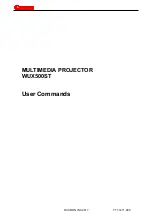
CP2000-XB Setup Guide
4-1
020-100250-02 Rev. 1 (06-2009)
4 Maintenance
NOTE:
The illustrations provided are to enhance the understanding of the written material. They are
graphical representations only and may not represent your exact projector model.
4.1
Maintenance and Cleaning
To help ensure optimized performance and reliability, regularly check electrical, optical and other
components as described below.
Warning!
SHOCK HAZARD. Disconnect projection head and
ballast from AC at BOTH wall breakers.
4.1.1 Electrical
Do the following every 60 days or 500 hours (always disconnecting from AC first):
• Check the contact surfaces of positive (anode) and cathode (negative) connections for cleanli-
ness. Clean electrical contact surfaces as necessary to prevent contact resistance from scorching
connectors.
• Verify that all electrical and lamp connections are tight.
4.1.2 Optical
Unnecessary cleaning of optics can be more harmful than helpful, increasing the risk of degrading
delicate coatings and surfaces. In this projector, check only the
lens
and
lamp reflector
—maintenance
of other optical components requires a qualified service technician. Check these components
periodically in a clean, dust-free environment using a high-intensity light source or flashlight. Clean
them
only
when dust, dirt, oil or other marks are obvious. Never touch an optical surface with your
bare hand—always wear latex lab gloves.
When to Check
LENS:
A small amount of dust or dirt on the lens has minimal effect on image quality—to avoid the
risk of scratching the lens, clean the lens
only
if absolutely required. See
Section Cleaning the Lens
below.
LAMP REFLECTOR:
Inspect the mirror surface (reflector) for cleanliness
only
during a lamp
replacement, when the lamp is out. If necessary, clean as described below—make sure to
wear
protective clothing
while inspecting or cleaning. Note that color variation on the reflector surface is
normal.
Supplies
For cleaning off dust and/or grease, you will need:
• Soft camel-hair brush
• Dust-free blower—filtered dry nitrogen blown through an anti-static nozzle.
• Dust-free lens tissue such as Melles Griot Kodak tissues (18LAB020), Optowipes (18LAB022) or
Kim Wipes or equivalent
Summary of Contents for CP2000-XB
Page 1: ...CP2000 XB S E T U P G U I D E 020 100250 02...
Page 2: ......
Page 40: ......
Page 52: ......
Page 66: ......














































